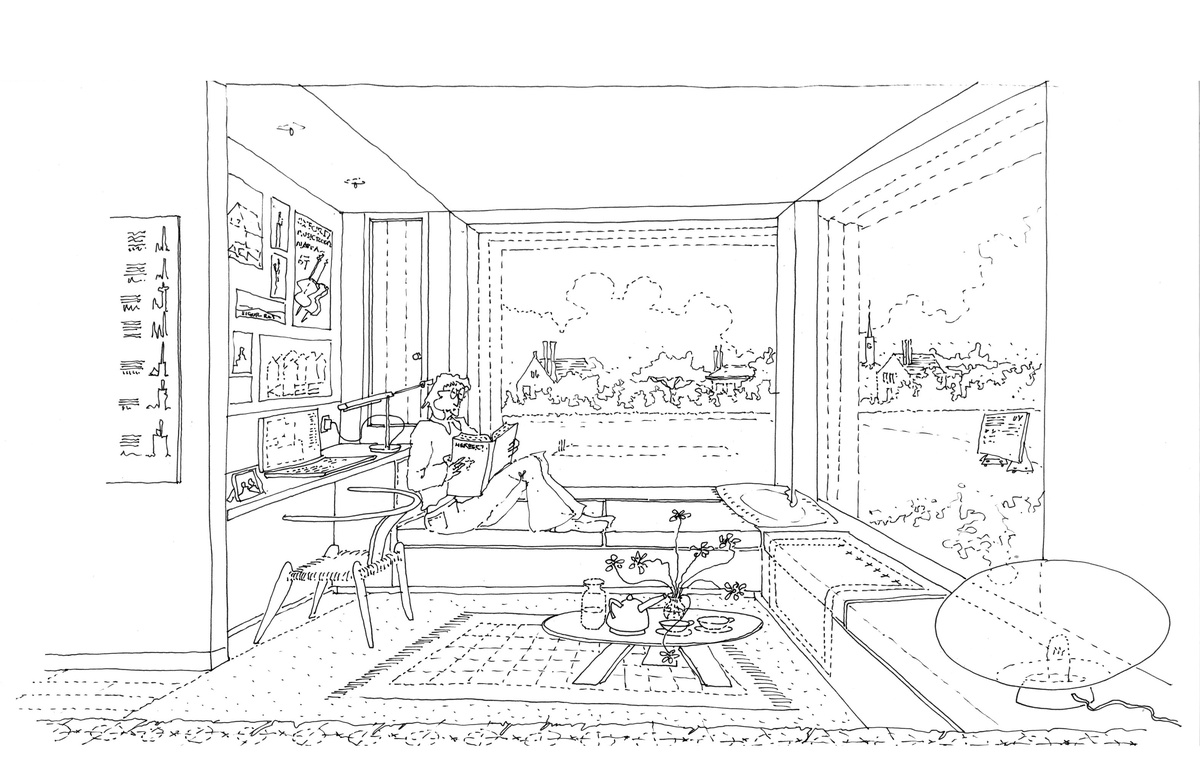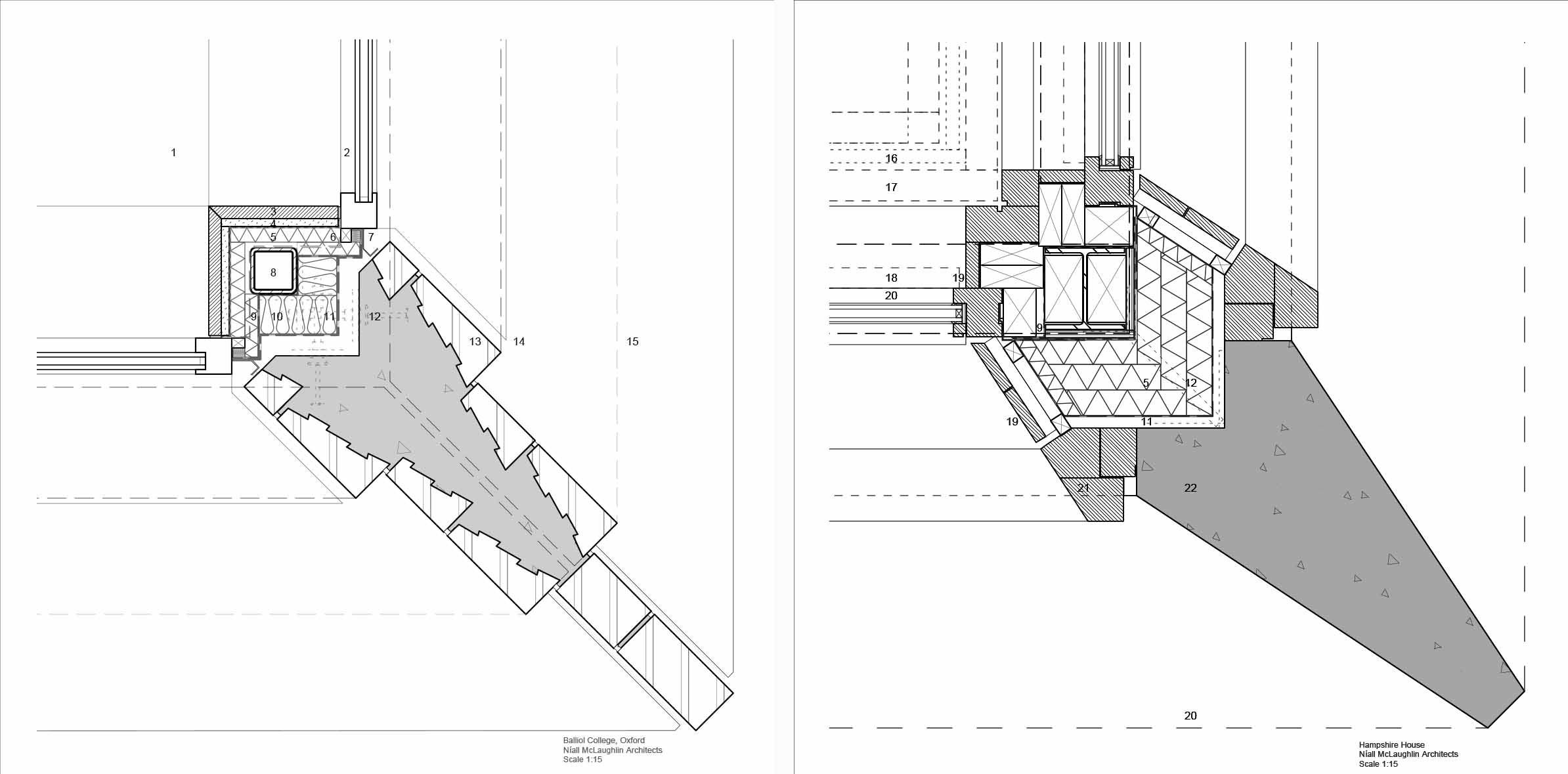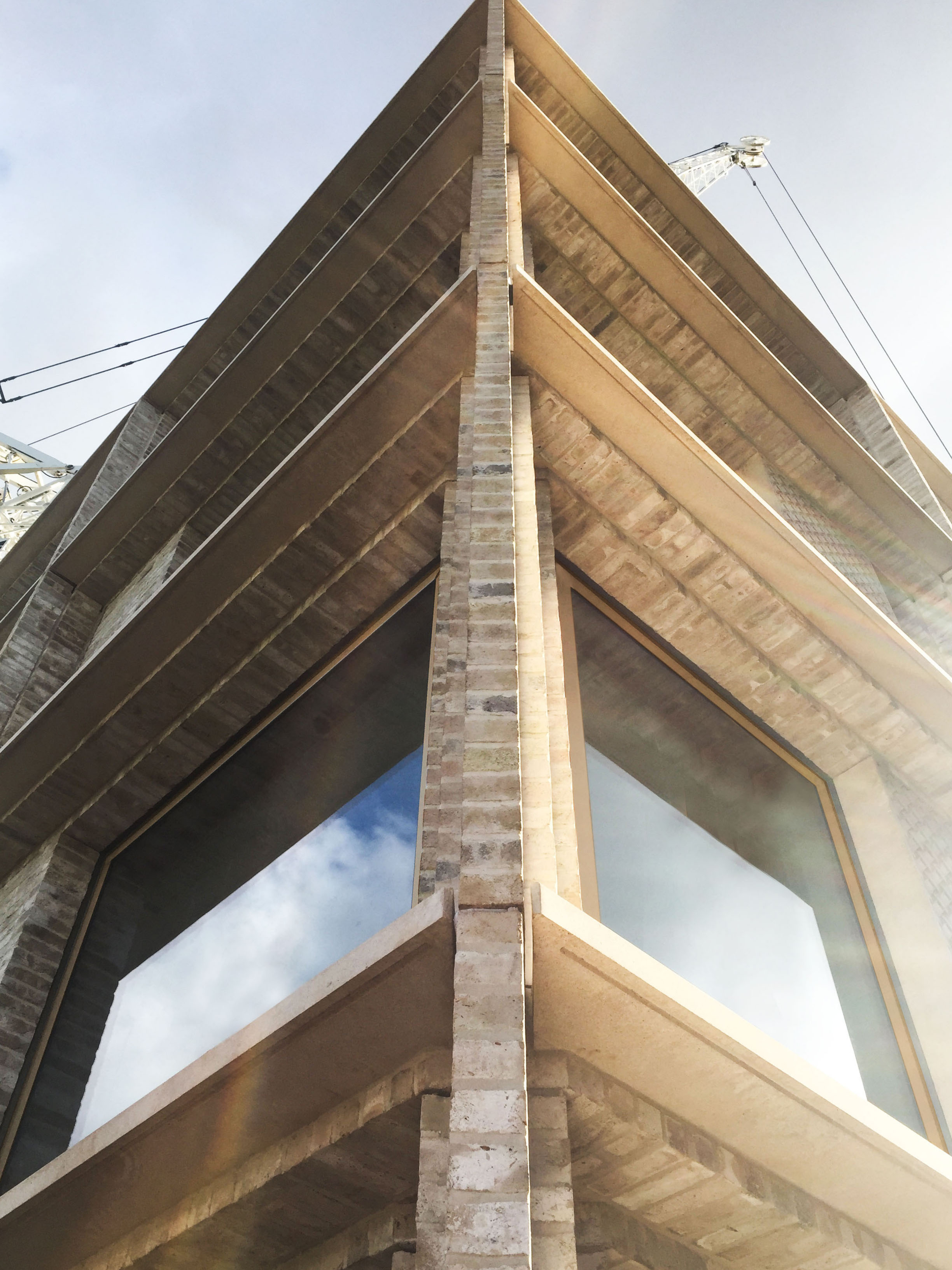MASTER’S FIELD PROJECT
APRIL 2019

When reflecting on the work of our practice, the chamfered corner, is a recurring interest. This detail has developed over the years from our preoccupations with the Miesian re-entrant corner, the simplicity of a trabeated structure, and a desire to find ways of expressing a deep façade.
Simple chamfers in concrete and stone were employed in recent completed projects for Hampshire House and The Sultan Nazrin Shah Centre, Oxford. At the Master’s Field site in Oxford, currently under construction for Balliol College, a corbelled chamfered detail is incorporated in a load bearing façade. This project comprises eight student accommodation buildings and a pavilion arranged around a series of courtyards overlooking a cricket pitch.

A brick-clad chamfer at the corner between two windows is used throughout the accommodation buildings. This establishes a shifting perspectival relationship as one moves through the site, and gives all the buildings a common language. Corbelled brick and concrete lintels and mullions set up a trabeated structural rhythm which clearly defines each individual student bedroom and creates a delicate play of light and shadow across the façade. A series of finely detailed brick and concrete panels are layered within the depth of the window reveal, articulating a secondary rhythm which expresses the transition from solid to glazed elements.
The detail enables the depth and structure of the wall to be elegantly expressed, maximizing its presence when viewed externally and minimizing its presence internally. It also forms a generous threshold which provides privacy for students inside engrossed in their study. For moments of welcome distraction, the large picture windows frame uninterrupted views over the cricket pitch and across the campus.
The expression of a chamfered corner produces challenges in construction, particularly when expressed in precast concrete components clad in corbelled brickwork. When forming acute angles with orthogonal bricks, special consideration must be given to alignments and bonding. Interface details demand careful thought regarding sequencing and tolerances to achieve a symbiosis of structural performance with aesthetic ambition.
Externally, in the plan detail shown here, the apex of the chamfer is formed from stacked brick headers. This exposes three faces of each brick, limiting the choice of bricks, which are typically produced with only one finished stretcher face. Brick specials are required to form the chamfered corbel of the lintels, and grids are carefully set out to ensure alignment of vertical and horizontal corbelling. We looked to the meticulously detailed and crafted brickwork of Jensen-Klint’s masterpiece, Grundvig’s Church in Copenhagen, for expression of stepped vertical forms.
Internally, minimising the corner where the windows meet produces intricate challenges in the alignment of linings, blinds, reveals and fitted furniture. This complex resolution of constituent parts all work hard to achieve the aesthetic objective of the simple glazed chamfered corner.

Detail Key
1.Whitewashed ply bench 2. Aluminium window 3.Whitewashed plywood reveal 4.Plasterboard 5.Rigid insulation 6.Steel window fixing brackets 7.Metal pressing 8.Wind post 9.EPDM/ vapour barrier 10.Mineral wool insulation 11.Breather membrane 12.Steel restraint brackets 13.Corbelled brick faced precast concrete mullion 14.Flashing 15.Concrete cill 16.Concealed curtain track 17.Oak joist over 18.Concealed roller blind 19.Timber panels 20.Timber framed window 21.Prelaminated timber frame 22.Precast concrete mullion 23.Precast concrete coping over
LARGE-SCALE MODEL MAKING
SEPTEMBER 2014
The use of physical models by architects is well established, and can be seen throughout history as the natural partner to drawings for exhibiting a proposal of the building prior to construction. Within our practice, models are rarely produced as mere presentation pieces, but rather as tools for exploration. This role makes them less precious and complete, with the ability to change and adapt the design following the feedback that the model has initiated.
The type of models that I enjoy most are those of a larger scale, of 1:20 and above where you are able to get your head inside and truly appreciate the space. In addition to the final form of such models, much is learnt through the process of construction. Structure, surfaces and junctions are some of the issues that require resolution during the making of the model. Within our studio space, we have a large area dedicated to model making, which allows for building and display of sizeable pieces.

During our work on a new build private residence in Hampshire, we carried out much of the design work on the external envelope through the use of physical models. They were worked up in increasing scales including a 1:10 piece of the facade. In particular, we were considering the form of the heavy external piers, fascias and cornices against the lighter timber elements that sat within them. We made the model using a similar sequence to the proposed building construction. We put the more solid facade elements in place so that we could begin considering a number of different forms for the timber window framing that sat within. The glazing was again produced in a similar method to the full-scale building, with a timber-framed bay built separately prior to installation in to the existing facade. We fixed these delicately so that removal would be possible.
We worked on a number of iterations of the window form, adapting the frames and constructing new versions when modification was not possible. Each time, the model was left on display within the studio so that everyone in the practice could consider the alternative versions and provide feedback. Once we had a favoured form, we used the same model to illustrate the proposal to the clients for approval.
I believe that such iterative assessments and amendments would only have been possible through the use of a large-scale physical model. Building models is about constructing space, and many of the activities are similar in technique and execution as the construction of a real building. By carrying out these actions in miniature we may appreciate the building as a physical form and understand the three dimensional mass. Building of models is our primary opportunity to test and refine our building form, whilst experiencing and discovering an approximation of the processes that will be required to make it.
Alastair Crockett studied at the University of Bath, University College London and London Metropolitan University. Since joining Niall McLaughlin Architects in 2012 he has worked on the T1 building in King’s Cross; a private residence in Hampshire and the Nazrin Shah Building for Worcester College in Oxford.



